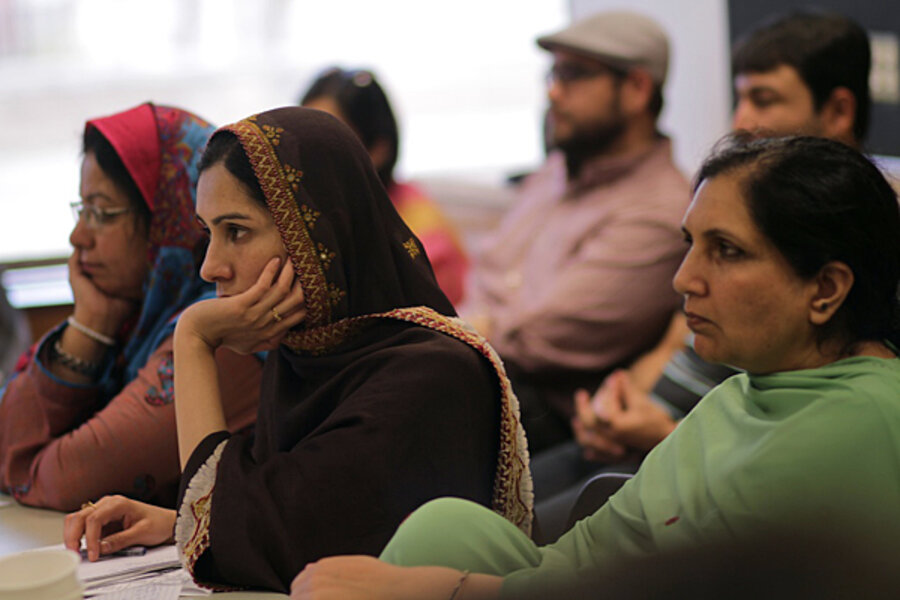Where the US and Pakistan are working together
Loading...
| New York City
Every few months, US-Pakistan relations seem to fall to a new low.
The latest tumble happened this week when the United States announced it had called off negotiations with Pakistan to reopen NATO supply routes.
But even as Washington and Islamabad figure out how to mend their struggling relationship, soft diplomacy efforts – and billions of dollars – are in place to keep US-Pakistan ties from fraying completely.
In fact, a group of 22 high-ranking Pakistani education officials and policymakers are in the US meeting with education experts. It's part of a first-of-its-kind, USAID-funded project to professionalize Pakistan's teachers and upgrade the quality of education in the nation's elementary and secondary schools.
The USAID Teacher Education Project alone may not patch the relationship between the US and Pakistan, but funding education projects is one way the US is able to support the kinds of moderate values that both the Pakistani government and the US say they want to promote.
“We need a strong civil society here in Pakistan that is safe and secure. We cannot produce that without good education,” says Mahmood ul Hasan Butt, director of the USAID Teacher Education Project, which is being implemented by EDC, a nonprofit based outside Boston.
Pakistan is having trouble attracting both teachers and students to classrooms. Dr. Butt attributes a large portion of these problems to the state of the teaching profession. Until now, there was no special training for teachers and few incentives to teach.
The USAID Teacher Education Project is a $75 million, five-year project under the Kerry-Lugar-Bergman Act. Since the project began in 2009, Pakistani teachers and policymakers have been meeting regularly in Pakistan, working on developing and implementing their own education policy changes, developing new syllabuses, and working with the higher education commission to implement new education degrees.
Pakistan is introducing both a two-year associate's degree and a four-year bachelor’s degree in education, with a plan to require a bachelor's degree in education by 2018. To encourage teachers to get the degree now, schools are offering higher pay to teachers with the new qualification.
Some in Pakistan criticize USAID’s approach to dispensing aid and Pakistan’s apparent dependence on it. The US has pumped $20.7 billion in aid into Pakistan since 2002 (some two-thirds military, the rest civilian). US lawmakers often complain that Pakistan does not cooperate as much as hoped, and have threatened to suspend aid. And in some cases have acted: After the doctor who helped the US track down Osama bin Laden was sentenced to 33 years in prison, the Senate voted to cut aid by $33 million. And more recently, the US cut $20 million for the Pakistani version of Sesame Street after USAID made allegations of fraud against the show's producers.
But Gita Steiner-Khamsi says this project is worth keeping.
“It’s a different approach to aid work. That’s what makes it interesting,” says Ms. Steiner-Khamsi, professor of education at Teachers College at Columbia University, which is a partner of the program. Rather than deliver an aid package and having the donor dictate how to implement it, this project gives ownership to Pakistanis, and US partners act as consultants, she says.
That furthers Pakistan’s goal to “move away from dependence and move to self-reliance,” says Butt. “It took America 50 years to transform its educational model. We’re trying to do that in five years,” he says, adding that the USAID project is helping accomplish something that should have been done years ago in Pakistan.
Today, almost 6,000 Pakistani students, policymakers, and faculty members from 75 colleges and 22 universities are expected to participate in the various project activities over the life of the project, according to administrators. They would presumably then help sustain the teacher education reform movement in Pakistan. So far, 51 out of 75 colleges have begun offering the new associate's degree. On top of that, some colleges and universities not associated with the project are starting to model it. Next year, when the first group graduates from the bachelor's degree program and starts teaching, officials will begin to assess how having better teacher credentials affects student success.
Hurdles
The 2015 United Nations Millennium Development Goals in education aim for Pakistan to have all children complete primary school and to reach gender parity in enrollments. But among Pakistan’s 170 million residents, some 40 percent are under the age of 14; getting these children – especially girls – to go to school is one of the biggest hurdles to educating Pakistan. Only 50 percent of girls and 60 percent of boys go to primary school.
Some participants worry about what will happen after the funding dries up in 2013. “The past few years have been good years for Pakistan’s education. If we needed something, we got it. Now money is tight,” says Maryam Rab, an administrator at Fatima Jinnah Women’s University.
Butt acknowledges this and says it’s a tough problem, but individual institutions will have to figure out ways to better manage their budgets. He’s confident the program will succeed.
It’s too soon to tell what that will look like in quantitative terms, say analysts, but the Kerry-Lugar-Bergman Act was designed to improve relations between regular Pakistanis and Americans, and these types of projects make a difference on a people-to-people level.
“The program,” says Perveen Munshi, dean of the Department of Education and professor at the University of Sindh, “is very wonderfully impressive.” She adds that as busy as it is – keeping her here in classes and back-to-back seminars at Teachers College, Columbia University – “it is bringing understanding not only of the US, but of all world education. This is one learning place.”







